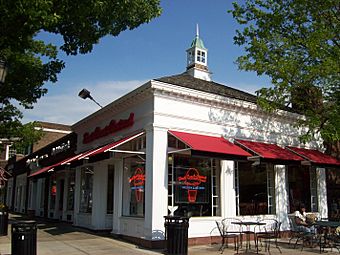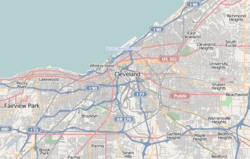Buckeye–Shaker facts for kids
Quick facts for kids
Buckeye–Shaker
|
|
|---|---|
|
Neighborhood of Cleveland
|
|
 |
|
 |
|
| Country | United States |
| State | Ohio |
| County | Cuyahoga County |
| City | Cleveland |
| Population
(2020)
|
|
| • Total | 11,680 |
| Demographics | |
| • White | 14.9% |
| • Black | 78.5% |
| • Hispanic (of any race) | 1.6% |
| • Asian and Pacific Islander | 4.9% |
| • Mixed and Other | 1.7% |
| Time zone | UTC-5 (EST) |
| • Summer (DST) | UTC-4 (EDT) |
| ZIP Codes |
44120
|
| Area code(s) | 216 |
| Median income | $30,448 |
| Source: 2020 U.S. Census, City Planning Commission of Cleveland | |
|
Shaker Square Historic District
|
|

Shops on the southeast corner of Shaker Square
|
|
| Location | Shaker and Moreland Blvds. Cleveland, Ohio |
|---|---|
| Built | 1927–1929 |
| Architectural style | Colonial Revival |
| NRHP reference No. | 83004367 |
| Added to NRHP | 1983 |
Buckeye–Shaker is a neighborhood located on the East Side of Cleveland, Ohio. It is made up of two smaller areas. In the south and west, you'll find the older Buckeye neighborhood. In the northeast, there's the Shaker Square neighborhood.
Shaker Square is famous for its historic shopping area. It also has a train station where light rail lines connect the city of Shaker Heights to downtown Cleveland. For many years, the Buckeye Road area was known as "Little Hungary." This was because it was the main home for Cleveland's Hungarian community. At one point, it was the largest Hungarian community outside of Hungary itself. Today, the area is mostly African-American.
Shaker Square is still known as one of Cleveland's best neighborhoods. People like it for its shops, restaurants, and beautiful buildings. It's also known for its diverse community and good quality of life.
Buckeye–Shaker is surrounded by other neighborhoods. To its west is Woodland Hills, and to the south is Mount Pleasant. University Circle is to the north, and the suburb of Shaker Heights is to the east.
Contents
Shaker Square: A Historic Hub
Shaker Square is a historic shopping center with a unique design. It was built between 1927 and 1929 by the Van Sweringen brothers. Its style is called American Colonial-Georgian, and it was inspired by town squares in Europe. The Van Sweringen brothers also developed the nearby planned community of Shaker Heights. They saw Shaker Square as a special entrance between city and suburban life.
The square has four large buildings around grassy areas. These buildings form an octagon shape. They were designed in a Neo-Georgian style. This design is said to be inspired by the eight-sided plaza at the Amalienborg Palace in Copenhagen, Denmark. Shaker Square was the second planned shopping center in the United States.
Today, Shaker Square is a busy center for the neighborhood. Around the square, there are many apartments, townhouses, and private homes. It has the largest number of multi-family homes in Cleveland.
Larchmere: A Lively District
The Larchmere district starts at North Moreland Boulevard and goes west to East 121st Street. This area is known for its many shops and homes. It also hosts fun yearly events like PorchFest and the Larchmere Festival.
Buckeye Road: Cleveland's "Little Hungary"
The Buckeye Road neighborhood was once called Little Hungary. It became the heart of Cleveland's Hungarian community in the late 1800s. By 1920, over 42,000 people in Cleveland were born in Hungary. Many of them lived in the Buckeye Road area.
Hungarian immigrants came to the United States hoping for a better life. Cleveland was a major industrial city at the time. Many Hungarians found jobs in factories and steel mills. They settled in this close-knit community because it was near their workplaces.
After World War II and until the 1970s, the neighborhood was a strong political area. Over time, many original Hungarian residents moved to the suburbs as they became more successful. By the early 2000s, only a few Hungarian residents remained. Today, the neighborhood is mostly African-American.
Benedictine High School is a Catholic high school located just south of Buckeye Road. It is famous for its football team and has a well-known alumnus, Chuck Noll.
Some interesting historic buildings in the area are listed on the National Register of Historic Places. These include the former St. Luke's Hospital, built in 1927. Also, there's St. Elizabeth of Hungary Catholic Church, built in 1892. The Weizer Building, built in 1928, is another notable spot.
| Historical population | ||
|---|---|---|
| Year | Pop. | ±% |
| 1940 | 19,537 | — |
| 1950 | 20,684 | +5.9% |
| 1960 | 19,066 | −7.8% |
| 1970 | 18,496 | −3.0% |
| 1980 | 16,347 | −11.6% |
| 1990 | 15,676 | −4.1% |
| 2000 | 16,063 | +2.5% |
| 2010 | 12,470 | −22.4% |
| 2020 | 11,680 | −6.3% |
| Source: | ||
Education in the Neighborhood
In 1912, a part of Buckeye–Shaker, near what is now Shaker Square, became part of the Shaker Heights school system. Today, Moreland Boulevard acts as a dividing line. Homes and businesses on or east of Moreland are in the Shaker Schools and Library District. This means they pay taxes to and vote for the Shaker Heights school and library systems.
However, homes and businesses west of Moreland are part of the Cleveland Metropolitan School District and Cleveland libraries. Because some residents can send their children to Shaker Schools, many people who work in Cleveland, especially in city government, have chosen to live in the Shaker Schools area of Buckeye–Shaker. This unique situation also made this area a center for Cleveland's black middle class before Shaker Heights became integrated.





